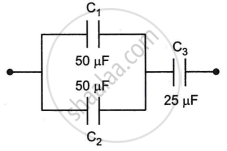Advertisements
Advertisements
Question
Calculate equivalent capacitance of the circuit shown in the Figure given below:

Solution
In the given figure,
C1 and C2 are connected in parallel so
C = C1 + C2
= 50 μF + 50 μF
= 100 μF
Here C is required with C3 in series, hence
`1/"C"_"eq" = 1/"C" + 1/"C"_3`
`= 1/100 + 1/25`
`= (1 + 4)/100`
`= 5/100`
`= 1/20`
⇒ Ceq = 20 μF
APPEARS IN
RELATED QUESTIONS
The plates of a parallel-plate capacitor are made of circular discs of radii 5⋅0 cm each. If the separation between the plates is 1⋅0 mm, what is the capacitance?
Three capacitors having capacitances 20 µF, 30 µF and 40 µF are connected in series with a 12 V battery. Find the charge on each of the capacitors. How much work has been done by the battery in charging the capacitors?
Find the equivalent capacitance of the system shown in figure between the points a and b.

The two square faces of a rectangular dielectric slab (dielectric constant 4⋅0) of dimensions 20 cm × 20 cm × 1⋅0 mm are metal-coated. Find the capacitance between the coated surfaces.
Three capacitors are connected in a triangle as shown in the figure. The equivalent capacitance between points A and C is ______.

Capacitors P and Q have identical cross-sectional areas A and separation d. The space between the capacitors is filled with a dielectric of dielectric constant Er as shown in the figure. Calculate the capacitance of capacitors P and Q.

A capacitor is charged by a battery. The battery is removed and another identical uncharged capacitor is connected in parallel. The total electrostatic energy of resulting system ______.
The capacitance of a parallel plate capacitor is 60 µF. If the distance between the plates is tripled and area doubled then new capacitance will be ______.
A 5µF capacitor is charged fully by a 220 V supply. It is then disconnected from the supply and is connected in series to another uncharged 2.5 µF capacitor If the energy change during the charge redistribution is `"X"/100`J then value of X to the 100 nearest integer is ______.
Two plates A and B of a parallel plate capacitor are arranged in such a way, that the area of each plate is S = 5 × 10-3 m 2 and distance between them is d = 8.85 mm. Plate A has a positive charge q1 = 10-10 C and Plate B has charge q2 = + 2 × 10-10 C. Then the charge induced on the plate B due to the plate A be - (....... × 10-11 )C

